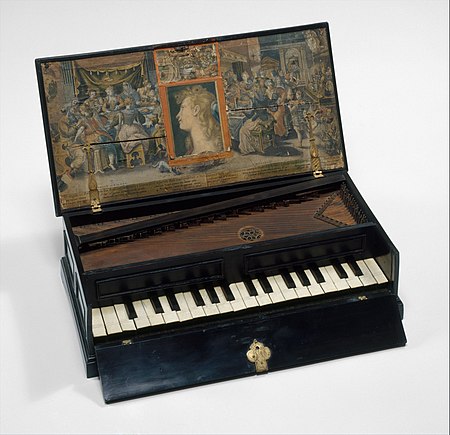What were small octave virginals used for? The compass seems too limited for anything musically useful.

Getting pitch references for vocal music?
What were small octave virginals used for? The compass seems too limited for anything musically useful.

Getting pitch references for vocal music?
Hello Andrew,
When I was young & beautiful I played a very small hand pumped harmonium with a range resembling your instrument. It was even transposable to up to 2 notes if I remember correctly. The instrument belonged to a convent where I accompanied the (bad) choir. All you can do is pump with your left hand and play the melody with your right hand. Think organetto & suchlike…
Regards,
Chris.
Indeed, Andrew, your picture shows a pretty decent 3-octaves short-bass-octave instrument. Actually I guess Baroque-era musicians were not too choosy as we are about playing masterpieces: they were happy (and this is well documented) with lots of run-of-the-mill music that just suited their interests and instruments. There are quite a few pieces, even very nice ones and composed by great masters such as English Virginalists, Frescobaldi and Louis Couperin, whose range fits into 3 octaves: transpose one octave up and there you are! F. Couperin also composed quite a few pieces within a 3 octave range, and a few also within a 2 octave range.
Needless to say, these small instruments are scarcely useful as continuo for a singer, say, and pointless in an ensemble: they were not meant for this use.
The range of the human voice, even assuming a choir rather than a single person, is about 3 octaves, except for freaky people. A lot of Renaissance keyboard music fits quite comfortably on my quadruple-fretted clavichord, after directions found in a Wroclaw monastery c. 1470, which is G-f’'. A bunch of it is intabulations of vocal music, of course. In fact, I will admit that the setting of Jannequin’s La Guerre found in the Johannes of Lublin manuscript would probably be less silly on the little virginals than on my clavichord.
Judy
We have contemporary evidence of what the octave spinets were used for. Burney reports:
‘Throughout Italy they have generally little octave spinets to accompany singing, in private houses, sometimes in a triangular form […]’ ( Charles Burney, The Present State of Music in France and Italy, London (T. Becket and Co.), 1771, p. 288 note).